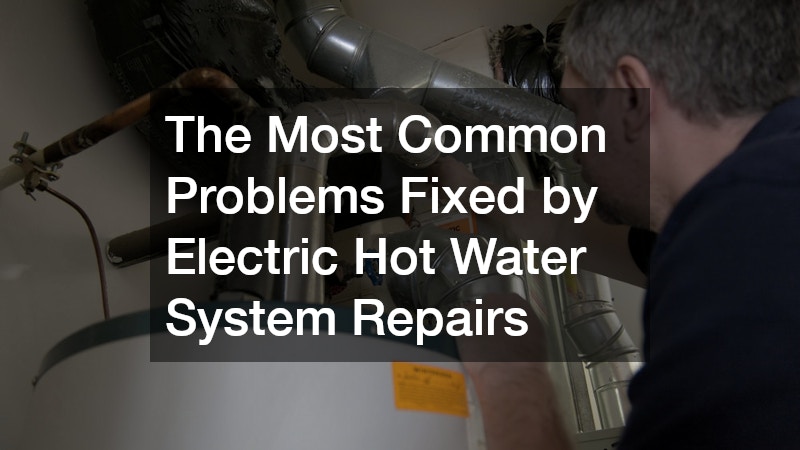Electric hot water systems are a staple in Australian households, providing reliable access to hot water for daily use. However, like any appliance, they can experience faults over time. While some issues are minor, others require professional attention to ensure safety and restore functionality.
Understanding the most common problems addressed by electric hot water system repairs can help homeowners detect early signs of trouble and make informed decisions. This guide explores typical issues, their causes and the best course of action when they arise.
No Hot Water
A complete loss of hot water is one of the most obvious signs something is wrong. This issue often points to a failed heating element or a tripped circuit breaker. In some cases, the thermostat may also be at fault, especially if the water is lukewarm rather than completely cold.
Before assuming the worst, it’s worth checking if the system has power. If the switchboard indicates a tripped circuit, resetting it might resolve the issue. However, if the problem persists, professional intervention is recommended. A licensed technician can safely assess whether the heating element or thermostat needs replacement.
Water Leaks Around the Tank
Water pooling around the base of the system could indicate a leak, which should never be ignored. Leaks may stem from faulty valves, corrosion or a crack in the storage tank. Over time, even minor leaks can lead to water damage, increased energy bills and mould growth.
In many cases, a pressure relief valve may be leaking due to high internal pressure. Alternatively, a worn-out anode rod might allow rust to weaken the tank. Regular inspections can catch these issues early. A technician will determine if the tank can be repaired or if replacement is more cost-effective.
Rust-Coloured or Smelly Water
Discoloured or foul-smelling hot water often suggests corrosion inside the tank or bacterial growth. This is especially common in systems that have not been serviced regularly. The sacrificial anode rod, which protects the tank from rusting, can degrade over time. If not replaced as part of routine maintenance, internal rust may contaminate the water.
In some cases, particularly with odours resembling rotten eggs, the issue could be linked to sulphur bacteria reacting with the anode. A professional can flush the tank and replace the rod to resolve the problem.
Unusual Noises from the System
Popping, hissing or rumbling noises coming from the unit usually point to sediment buildup at the bottom of the tank. Over time, minerals in the water can accumulate, especially in areas with hard water. These sediments reduce heating efficiency and can damage the tank.
If left untreated, the added strain can lead to overheating or even tank failure. Flushing the tank is a routine part of electric hot water system repairs and can significantly extend the life of the unit.
Inconsistent Water Temperature
Fluctuating water temperature can be both frustrating and indicative of a larger issue. A failing thermostat or a damaged heating element may cause hot water to run out quickly or heat unevenly. This problem is common in older systems but can also affect newer units if there’s a manufacturing fault or improper installation.
Rather than adjusting the thermostat settings repeatedly, it’s best to have the system inspected. Prompt diagnosis prevents further wear and ensures efficient operation.
Low Water Pressure
Reduced hot water pressure, especially when cold water pressure remains strong, can signal a blockage in the hot water line. This may result from sediment or mineral buildup in the pipes or a partially closed valve.
Low pressure not only impacts comfort but can also strain the heating system. In many cases, the issue can be resolved through pipe cleaning or valve adjustment. However, professional advice is essential to rule out more serious causes.
When to Call a Professional
While some issues might seem simple, attempting DIY repairs on an electric hot water system can be dangerous without proper training. Electrical components, pressurised tanks and scalding water all pose safety risks. If your system shows any of the problems listed above, it’s time to contact a licensed technician.
Electric hot water system repairs cover a wide range of services, from replacing faulty elements to flushing tanks or fixing leaks. Regular maintenance not only resolves current faults but also helps prevent future issues by keeping the system in peak condition.
Electric hot water systems are built to last but are not immune to wear and tear. From no hot water to unusual noises or leaks, recognising the signs of trouble is key to maintaining a safe and efficient supply. Most issues are straightforward to resolve when caught early, but delays can result in costly damage or system failure.
Whether your system needs a minor fix or a full diagnostic check, professional system repairs offer peace of mind. Staying on top of maintenance and addressing problems promptly ensures your hot water system continues to serve your home reliably for years to come.
.

